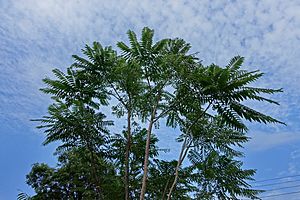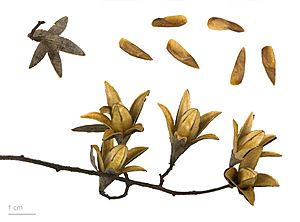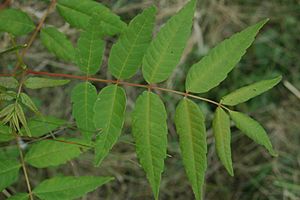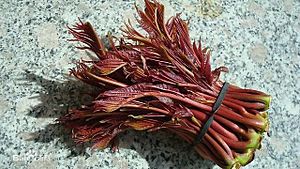Chinese mahogany facts for kids
Toona sinensis, also known as Chinese mahogany or Chinese toon, is a special type of tree. People sometimes call it the beef and onion plant because of its unique smell and taste! This tree grows naturally in many parts of eastern and southeastern Asia. You can find it from North Korea all the way south to countries like China, Nepal, India, Myanmar, Thailand, Malaysia, and Indonesia.
Quick facts for kids Chinese mahogany |
|
|---|---|
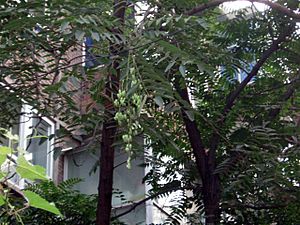 |
|
| Foliage and seed capsules | |
| Scientific classification | |
| Genus: |
Toona
|
| Species: |
sinensis
|
| Synonyms | |
|
Synonyms list
|
|
Contents
Characteristics of the Chinese Toon Tree
The Chinese toon is a deciduous tree. This means it loses its leaves every year, usually in autumn. It can grow quite tall, up to 25 meters (about 82 feet). Its trunk can be as wide as 70 centimeters (about 28 inches).
The bark of young trees is smooth and brown. As the tree gets older, its bark becomes more rough and shaggy. The leaves are very large, about 50–70 cm (20–28 inches) long. They have many smaller leaflets, usually between 10 and 40.
When the young leaves first appear, they are reddish-brown or purple. They also have a special smell, often described as onion-like. In summer, the tree produces small, white or pale pink flowers. These flowers grow in large clusters at the ends of the branches. After the flowers, the tree grows golden-colored fruits. These fruits are like small capsules, about 2–3.5 cm (1–1.4 inches) long. Each capsule holds several winged seeds.
The Chinese toon tree looks a bit like another tree called Ailanthus altissima. However, you can tell them apart by their leaves' smell. Also, the Chinese toon has rough bark, while A. altissima has smooth bark.
How Chinese Toon is Grown
Chinese toon trees can be grown in a few different ways. They can grow from seeds, from cuttings (pieces of the plant), or through a special lab method called tissue culture.
Growing from Seeds
Growing Chinese toon from seeds is a good way to get many young trees. This is useful for large farms. Soaking the seeds in warm water before planting helps them sprout better. In East Asia, people usually plant the seeds in late March or early April. The exact time can change depending on where you live. Young trees grown from seeds in spring can be moved to their permanent spot in the fall.
Growing from Cuttings
Another way to grow Chinese toon is by using cuttings. This means taking a piece of a stem or root from a grown plant. Then, you plant this piece in moist soil. This method often has a higher success rate for young trees. Stems that are partly woody work best for cuttings. Special plant hormones can also help the cuttings grow roots. In East Asia, people usually take cuttings in late June or early July.
Tissue Culture
Tissue culture is a more advanced way to grow plants in a lab. It started being used for Chinese toon in China in the late 1980s. This method involves growing tiny pieces of the plant in a special nutrient gel. Scientists use this method to grow specific types of Chinese toon, especially rare ones.
Uses of Chinese Toon
The Chinese toon tree is very useful! People use it for food, as a building material, and even in traditional medicine.
Food and Nutrition
The young leaves of the Chinese toon are a popular vegetable in China. They have a unique flavor that is both floral and a bit like onion. This special taste comes from natural compounds in the leaves. People often say that trees with reddish young leaves taste better than those with green ones.
In China and some Southeast Asian countries like Malaysia, people make a paste from the young leaves. This "Toona paste" is used like a condiment. It's great with plain rice porridge for breakfast or to add flavor to dishes and soups. Some popular dishes include Chinese Mahogany fried rice, Chinese Mahogany beancurd, and Chinese Mahogany mushroom soup.
The leaves are also healthy! They contain Vitamin E and good amounts of iron, calcium, and chlorophyll.
Material
The wood from the Chinese toon tree is hard and has a reddish color. It's quite valuable. People use it to make furniture and even parts of electric guitars. It's often used as a more affordable substitute for "true mahogany" wood.
Outside of Asia, the Chinese toon is also grown as a beautiful ornamental tree. It's known for its interesting, rugged look. It's also one of the few trees in its plant family that can grow well in colder places, like northern Europe.
Medicine
In Traditional Chinese medicine (TCM), the leaves of the Chinese toon are believed to help with digestion and coughs. They are also thought to help stop bleeding.
Modern research has looked into the health benefits of Chinese toon leaves. Some studies suggest that certain substances in the leaves might help protect liver cells. Other studies show that compounds from the leaves can act as natural antioxidants. Antioxidants help protect your body's cells from damage.
Things to Know About Chinese Toon Leaves
Chinese toon leaves naturally contain a substance called nitrite. However, if you boil the leaves in water, most of the nitrite goes away, making them safe to eat. It's important to know that the amount of nitrite can increase over time. So, it's best not to store Chinese toon leaves for too long after picking them.
Scientists are still studying Chinese toon. They continue to discover more about its properties and potential uses.
Culture
In Chinese literature, the Chinese toon tree is often used as a symbol. A mature Chinese toon tree can represent a father. This idea appears in a common saying used to wish someone's parents well. People might say, "wishing your Toona sinensis and daylily are strong and happy." Here, the Chinese toon refers to the father, and the daylily refers to the mother.
Images for kids
See also
 In Spanish: Caoba china para niños
In Spanish: Caoba china para niños


